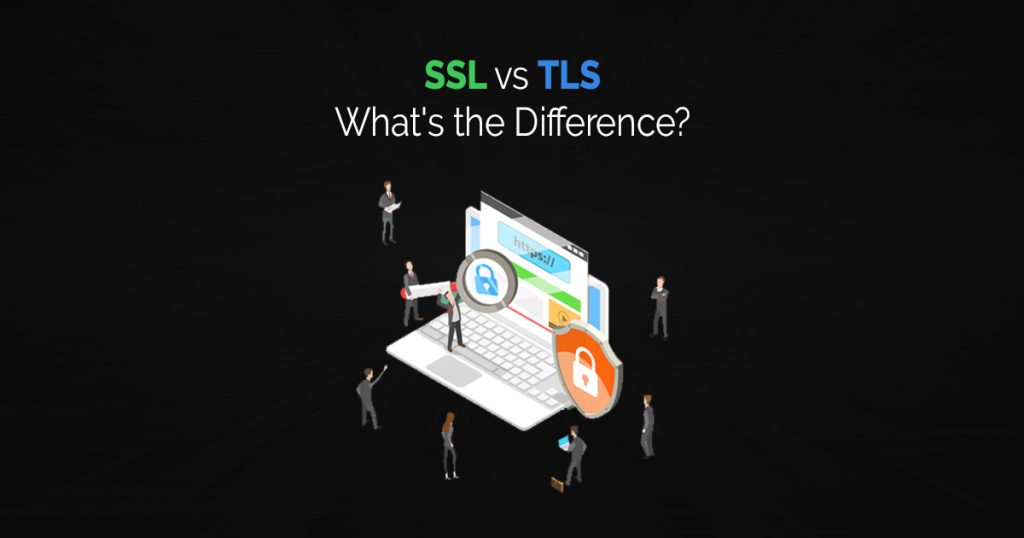Both TLS and SSL are protocols that are used for secure transmission of data over the internet. In addition, they provide authentication to data. But what is the difference between SSL vs TLS? Is it really something you need to worry about?
In this blog,I will discuss about the main differences between SSL vs TLS. You will also be able to learn that how these two protocols connect to HTTPS. You will be also learning the reason that why do actually do not have to worry too much of the better option between SSL vs TLS. I will also let you know that it is not a big concern that either you are using “SSL certificate” or a “TLS certificate”.
What is the difference between TLS and SSL?
TLS, short for Transport Layer Security, and SSL, short for Secure Socket Layers, are both cryptographic protocols. While moving data over the internet, these two protocols encrypt data and authenticate the connection. For example, if you’re processing credit card payments on your website, TLS and SSL can assist in making a secure process. Thus allowing the data to be safe and away from malicious actors so they can’t get their hands on it.
The basic difference between SSL and TLS is of the latest version. TLS is actually just a more recent version of SSL. The plus point of TLS is that it covers up a couple of security vulnerabilities that were present in earlier SSL protocols.
A brief History
Before we move forward towards more of the specifics, it’s essential to understand the basic history of SSL and TLS.
In February 1995, SSL 2.0 was first released. It is worthy to note here that SSL 1.0 was never publicly released as it had some major security flaws. Still, some security flaws existed in SSL 2.0 but it was publicly released. In 1996, SSL 3.0 quickly replaced SSL 2.0 as SSL 2.0 was also not a version without any error.
SSL 3.0 worked well and after three years in 1999, the first version of TLS (1.0) was released. TLS (1.0) is an upgrade to SSL 3.0. After the first version of TLS, there have been three more TLS releases, with the most recent release was of TLS 1.3 in August 2018.
Uptil now, both public SSL releases have been denounced and have known security vulnerabilities.
How Do TLS and SSL Work to Secure Data?
Here’s the high-level technique for how each SSL and TLS work.
When you set up an SSL/TLS certificates on your web server (often simply known as an “SSL certificate), it consists of a public key and a private key that authenticate your server and let your server encrypt and decrypt data.
When a visitor goes to your site, their internet browser will look for your site’s SSL/TLS certificate. Then, the browser will operate a “handshake” to check the validity of your certificates and authenticate your server.
Once a visitor’s browser determines that your certificates is legitimate and authenticates your server, it essentially creates an encrypted hyperlink between it and your server to securely transport data.
This is additionally the place HTTPS comes in (HTTPS stands for “HTTP over SSL/TLS”).
HTTP, and the more current HTTP/2, are application protocols that play an vital position in transferring statistics over the Internet.
With undeniable HTTP, the fact is that it is prone to attacks. But when you use HTTP over SSL and TLS (HTTPS), you encrypt and authenticate at some stage while transferring, which makes it secure.
This is why you can safely process credit card details over HTTPS however now not over HTTP, and additionally why Google Chrome is pushing so challenging for HTTPS adoption.
TLS is the latest version
Above, you realized that TLS is the more latest version of SSL and that each public releases of SSL have been deprecated for a couple of years and include recognised security vulnerabilities.
That may have you wondering: why is it known as an SSL certificates and no longer a TLS certificate? After all, TLS is the modern, safety protocol.
No, the purpose why most human beings nevertheless refer to them as SSL certificates is essentially a branding issue. Most principal certificates vendors nevertheless refer to certificates as SSL certificates, which is why the naming convention persists.
That is, you can use any one from the SSL and TLS protocols with your certificate.
There’s no such factor as simply an SSL certificates or simply a TLS certificate, and you don’t want to fear about changing your SSL certificates with a TLS certificate.
Should You Use TLS or SSL? Is TLS Replacing SSL?
Yes, TLS is changing SSL. And yes, you must use TLS rather of SSL.
As you realized above, each public releases of SSL are deprecated in large section due to the fact of known safety vulnerabilities in them. As such, Symantec SSL is now not a completely secure protocol in 2019 and beyond.
TLS, the more modern-day model of Thawte SSL, is secure. What’s more, recent variations of TLS additionally provide overall performance advantages and different improvements.
Not solely is TLS extra impenetrable and better in performance, most contemporary net browsers no longer assist SSL 2.0 and SSL 3.0. For example, Google Chrome stopped aiding SSL 3.0 all the way lower back in 2014, and most primary browsers are planning to quit assisting TLS 1.0 and TLS 1.1 in 2020.
In fact, Google started out displaying ERR_SSL_OBSOLETE_VERSION warning notifications in Chrome.
Conclusion
You do no longer want to worry about “changing” your SSL certificates into a TLS certificate. If you’ve already set up an “SSL certificate”, you can be assured that it additionally helps TLS.
It’s vital to use the modern-day versions of TLS due to the fact SSL is no longer secure, however your certificates does no longer decide the protocol that your server uses. Instead, as soon as you have a certificate, you can pick out which protocols to use at a server level.

